Joker 2015 Java Conference Report
October 16-17, 2015 in St. Petersburg, the Joker 2015 conference took place. Within 2 days, more than 30 reports related to development in the Java programming language were read. Who was among the speakers, what reports could see what seemed interesting, this is described below.

The Joker 2015 conference is held annually for the third time in a row, while it is always in St. Petersburg and always in October. Joker is the twin brother of another Java conference, the JPoint . JPoint is also held annually, also held three times, it happens in April in St. Petersburg ( JPoint 2013 ) or Moscow ( JPoint 2014 , JPoint 2015 ). Both conferences are being made by the same JUG.RU team.
Over the time since JPoint 2015 to Joker 2015 :
')
I took the opportunity to view the conference online. When selecting reports, it was primarily guided by the personalities of the speakers, then the topic of other reports. Therefore, the reports of Aleksey Shipilev, Yevgeny Borisov and Nikolai Alimenkov were immediately selected. It is a pity that there were no reports by Baruch Sadogursky and Sergey Kuksenko. Sergey was as a conference participant, Baruch was invisibly present in the form of a photo on cardboard in full growth. Photo Sergei Kuksenko with cardboard Baruch .
My choice of reports does not mean at all that other reports are worse - this is just my choice and only while watching the conference. Choosing specific reports during the conference, do not lose the opportunity to view the rest. Be sure to selectively look at the video of the remaining reports, the link to view them has already come by mail.
Welcome word from the organizers. Three first photos from left to right - Alexey Fedorov, Ivan Dolgov, Andrey Dmitriev. The following two photos - Andrey Pangin and Oleg Anastasyev (representatives of sponsors and speakers).

Representatives of the sponsoring companies, respectively, EPAM , Deutsche Bank , T-Systems and Sberbank-Technology (the last two photos). Alexander Matorin (the penultimate photo) was also a conference speaker.

Practicing at the Cutting Edge
Martin thompson
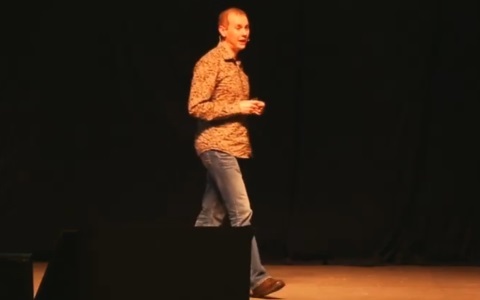
LMAX , the co-founder and CTO of which Martin is, has gained wide popularity for Disruptor software.
In his report, Martin, based on his own experience, made a retrospective of building software products using Java . I tried to make a comparison with the development in C / C ++ , to reveal the techniques of application design and the interaction with the hardware to achieve high performance. He mentioned the need for a culture of development and explained what is required for this.
The story reminded me of the Java Life Story reports by Ani Barsky and the Java Platform: the past and the future of Vladimir Ivanov. In all three cases, there are different aspects of Java and their change over time is shown.
Spring Puzzlers: the subtleties and nuances of Spring
Yevgeny Borisov

Spring Puzzlers Report - Beginning at JPoint 2015 Baruch Sadogursky and Yevgeny Borisov held together. Unfortunately, this time Baruch was present only in cardboard version, Zhenya conducted one report.
In my opinion, Baruch and Eugene make up the perfect speaker-tandem. Being both excellent speakers and highly qualified, they complement each other perfectly. The expressive Baruch is well set off by the calm Zhenya. The format of “Groovy Puzzlers” and “Spring Puzzlers” also looks better in a joint performance.
The current release of Spring Puzzlers largely coincided with the one already presented six months ago at the JPoint . It seems to me that Eugene this time managed to manage to ask more riddles, since a part of time was spent on the JPoint to solve technical problems. I repeat once again that Baruch was sorely lacking.
The Lord of the Strings: Two Scours
Alexey Shipilev, Oracle

Alexey has an amazing ability to collect full rooms for his reports, fascinating and interesting by telling them about difficult things.
This report described the development of two features that should soon appear in JDK / JVM - Compact Strings and Indify String Concat . Compact Strings implements a compact representation of strings with single-byte characters, Indify String Concat transfers the execution of string concatenation to the execution time. Implementing one or the other (or both) also significantly increases the performance of string operations.
Excellent report and an excellent speaker, I enjoyed watching.
Functional style refactoring
Alexander Matorin, Sberbank-Technology

Alexander told about functional programming techniques when performing refactoring of code written in Java . All the techniques presented were based on features introduced in Java 8 . Not limited to using the Stream API , which is observed most often in practice. Considered and demonstrated the use of partial application of functions and currying. He focused on maximizing declarativeness in the code.
Expressive and useful report. As it turned out the next day, this report well supplemented Nikolai Alimenkov, which is further.
Ping-pong programming
Anton Keks and Andrey Solntsev, Codeborne

Anton and Andrei demonstrated a pair programming style actively practiced at Codeborne :
The idea is good, the first 15-20 minutes looks quite lively. At the end of the speech, the students actively asked questions for half an hour. It would be perfect and it would be better if the first half hour showed the use of the proposed practice, the second half hour - to answer questions.
The Macro of Microservices
Josh Long, Pivotal
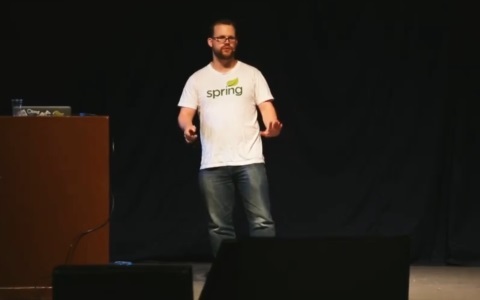
Josh is an employee of Pivotal , the author of 5 books. At the same time, it is the Developer Advocate of the Spring project. Has more to do with Spring Boot , Spring Cloud and Spring Integration .
Using the example of the service, Netflix showed a consistent movement from a monolithic architecture to an architecture using microservices.
Live report looks easy. To enhance the effect, you probably need to watch his report of the next day, “The Bootiful Application”, which I have missed so far.
Get Past the Syntax
Venkat subramaniam

Of all the invited English speakers who have so far managed to see, Venkat made the strongest impression. To enhance the effect when reading the report, he additionally successfully helped himself with facial expressions and gestures. Regardless of the topic of the report was curious to see.
The report dealt with the importance of the semantics of language (natural and programming) in comparison with syntax . The fact that the perception of syntax and semantics of the language depends on the current experience and knowledge. Everything declared was illustrated with examples from both natural language (English) and various programming languages.
I recommend, even if the topic of the report is not interesting, to watch a fragment of the video to assess the skill of the speaker.
WILD microSERVICES
Kirill Tolkachev and Alexander Tarasov, Alfa-Bank

Kirill Tolkachev is known to me because he has recently been co-host of this podcast (if I'm not mistaken, from the release about OSGi ). Alexander Tarasov, this is directly related to the topic of the report, recently at CodeFreeze I gave a talk about Docker . These two reasons seemed to me sufficient to select their joint report on microservices.
The report seemed to me very dynamic, well coordinated and well-rehearsed. For demonstration of writing microservices, Groovy and Java programming languages were used, frameworks - Spring and Thrift , products - Docker and Consul .
After the report, the listeners were asked relevant questions, to all of them, Kirill and Alexander successfully answered. I did not regret that I chose this report.
What to expect from Java 9?
Ivan Krylov, Azul Systems

Ivan Krylov works for Azul , which is known for its Zing products (its own JVM implementation) and Zulu (its own supported OpenJDK build). I have already listened to other reports by Ivan, so my choice of speaker and report was also deliberate.
It was interesting and useful to get acquainted with the kindly collected and systematized information about the new features of Java 9 . Probably not all the features that were described will be included in the final version. If you are interested in qualified and well-submitted information on this topic, I highly recommend this report.
A modern look at the implementation of classic design patterns in Java
Nikolay Alimenkov, EPAM / XPInjection
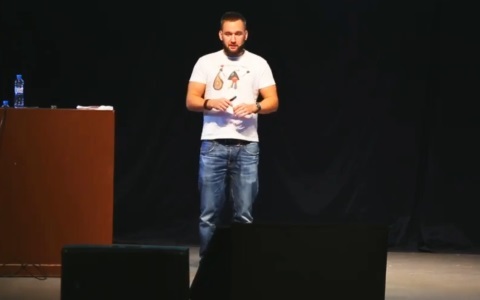
It seems to me that the main merit of Nikolai (for me, as a listener) is the organization of the JEEConf conference, which takes place annually in Kiev. Alas, I have never attended full-time, but repeatedly enjoyed access to videos and presentations.
I always choose Kolya's reports, if available in the program. The report outlined a look at the classic design patterns in the modern environment of language capabilities and actively used frameworks. Many theses are quite controversial, which caused the questions from the audience to be asked.
The report of Nikolai, in my opinion, to some extent complements the report of Alexander Matorin.
Java client outside the browser: we make native Java clients
Nikita Lipsky, Excelsior
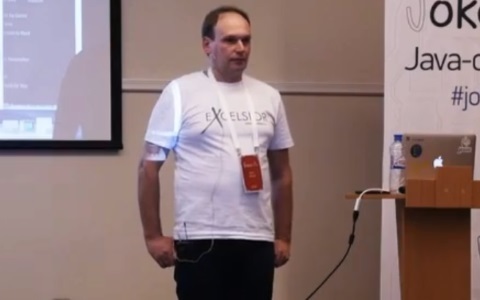
I would characterize the report as an overview of the Excelsior JET product, produced in the company where Nikita works. The report accurately repeated the already presented at the JEEConf 2015 conference, which I had already managed to look at in the recording.
The report is good, but I expected some additional details about the implementation of support for Java 8 , which recently appeared in the product, to what was said earlier.
For those who wish to have more technical details, I recommend watching the performance of Nikita Lipsky and Pavel Pavlov on JUG.RU:
Within three hours, there it is exhaustively told about the history of creation and the architecture of the product with its demonstration.
Iconoclasm
Ted neward

The final report of the last day of the conference was a non-technical report on the rebels or, if expressed in stamps, the role of the individual in history (science, culture, art, IT-industry).
Expanded your horizons by learning about the following:
I think that sometimes diluting technical reports with something similar is a good practice.
Alexey Fedorov, Ivan Dolgov and Andrei Dmitriev at the closing of the conference.
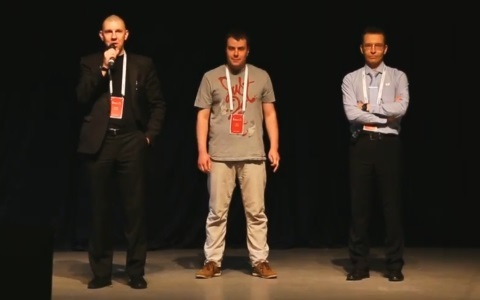
Invited by Alexei Fyodorov to the stage, all members of the organizing team, along with volunteers.

Additionally, all the conference speakers joined them.

The only negative point is the recurring problems with lunch. On the second day, the decision was to organize a lunch in two shifts.
There are much more positive sides:
If there is no possibility of attending the conference in person, the online broadcast can help:
Alas, you lose the opportunity of personal communication with participants and speakers.
Constructive suggestions for improving the already excellent event:
On October 18, University Day was held with the age limit of participants (no older than 24 years). Judging by the topics of reports and speakers, there was also something interesting to see. Since there was no legal opportunity to get acquainted with the reports, it would be possible to provide access to the records at least to the participants of the main Joker 2015 conference.
Many thanks to the organizers and speakers of the conference!

The Joker 2015 conference is held annually for the third time in a row, while it is always in St. Petersburg and always in October. Joker is the twin brother of another Java conference, the JPoint . JPoint is also held annually, also held three times, it happens in April in St. Petersburg ( JPoint 2013 ) or Moscow ( JPoint 2014 , JPoint 2015 ). Both conferences are being made by the same JUG.RU team.
Over the time since JPoint 2015 to Joker 2015 :
')
- Alexey Fedorov on Habrahabr several announcements of the conference were published;
- three interviews from the No Slides series ( with Dmitry Zhemerov , Andrey Pangin and Alexey Shipilyov ) also appeared there;
- future conference speakers had time to speak at JUG.RU , CodeFreeze and jug.msk.ru.
I took the opportunity to view the conference online. When selecting reports, it was primarily guided by the personalities of the speakers, then the topic of other reports. Therefore, the reports of Aleksey Shipilev, Yevgeny Borisov and Nikolai Alimenkov were immediately selected. It is a pity that there were no reports by Baruch Sadogursky and Sergey Kuksenko. Sergey was as a conference participant, Baruch was invisibly present in the form of a photo on cardboard in full growth. Photo Sergei Kuksenko with cardboard Baruch .
My choice of reports does not mean at all that other reports are worse - this is just my choice and only while watching the conference. Choosing specific reports during the conference, do not lose the opportunity to view the rest. Be sure to selectively look at the video of the remaining reports, the link to view them has already come by mail.
Conference opening
Welcome word from the organizers. Three first photos from left to right - Alexey Fedorov, Ivan Dolgov, Andrey Dmitriev. The following two photos - Andrey Pangin and Oleg Anastasyev (representatives of sponsors and speakers).

Representatives of the sponsoring companies, respectively, EPAM , Deutsche Bank , T-Systems and Sberbank-Technology (the last two photos). Alexander Matorin (the penultimate photo) was also a conference speaker.

Reports
Practicing at the Cutting Edge
Martin thompson

LMAX , the co-founder and CTO of which Martin is, has gained wide popularity for Disruptor software.
In his report, Martin, based on his own experience, made a retrospective of building software products using Java . I tried to make a comparison with the development in C / C ++ , to reveal the techniques of application design and the interaction with the hardware to achieve high performance. He mentioned the need for a culture of development and explained what is required for this.
The story reminded me of the Java Life Story reports by Ani Barsky and the Java Platform: the past and the future of Vladimir Ivanov. In all three cases, there are different aspects of Java and their change over time is shown.
Spring Puzzlers: the subtleties and nuances of Spring
Yevgeny Borisov

Spring Puzzlers Report - Beginning at JPoint 2015 Baruch Sadogursky and Yevgeny Borisov held together. Unfortunately, this time Baruch was present only in cardboard version, Zhenya conducted one report.
In my opinion, Baruch and Eugene make up the perfect speaker-tandem. Being both excellent speakers and highly qualified, they complement each other perfectly. The expressive Baruch is well set off by the calm Zhenya. The format of “Groovy Puzzlers” and “Spring Puzzlers” also looks better in a joint performance.
The current release of Spring Puzzlers largely coincided with the one already presented six months ago at the JPoint . It seems to me that Eugene this time managed to manage to ask more riddles, since a part of time was spent on the JPoint to solve technical problems. I repeat once again that Baruch was sorely lacking.
The Lord of the Strings: Two Scours
Alexey Shipilev, Oracle

Alexey has an amazing ability to collect full rooms for his reports, fascinating and interesting by telling them about difficult things.
This report described the development of two features that should soon appear in JDK / JVM - Compact Strings and Indify String Concat . Compact Strings implements a compact representation of strings with single-byte characters, Indify String Concat transfers the execution of string concatenation to the execution time. Implementing one or the other (or both) also significantly increases the performance of string operations.
Excellent report and an excellent speaker, I enjoyed watching.
Functional style refactoring
Alexander Matorin, Sberbank-Technology

Alexander told about functional programming techniques when performing refactoring of code written in Java . All the techniques presented were based on features introduced in Java 8 . Not limited to using the Stream API , which is observed most often in practice. Considered and demonstrated the use of partial application of functions and currying. He focused on maximizing declarativeness in the code.
Expressive and useful report. As it turned out the next day, this report well supplemented Nikolai Alimenkov, which is further.
Ping-pong programming
Anton Keks and Andrey Solntsev, Codeborne

Anton and Andrei demonstrated a pair programming style actively practiced at Codeborne :
- First, the first programmer writes a unit test that fails.
- Further, the second programmer writes the implementation of the functionality for which the test was previously written, the test passes. He writes the next unit test, which does not pass.
- The first programmer writes the implementation of the second functionality.
The idea is good, the first 15-20 minutes looks quite lively. At the end of the speech, the students actively asked questions for half an hour. It would be perfect and it would be better if the first half hour showed the use of the proposed practice, the second half hour - to answer questions.
The Macro of Microservices
Josh Long, Pivotal

Josh is an employee of Pivotal , the author of 5 books. At the same time, it is the Developer Advocate of the Spring project. Has more to do with Spring Boot , Spring Cloud and Spring Integration .
Using the example of the service, Netflix showed a consistent movement from a monolithic architecture to an architecture using microservices.
Live report looks easy. To enhance the effect, you probably need to watch his report of the next day, “The Bootiful Application”, which I have missed so far.
Get Past the Syntax
Venkat subramaniam

Of all the invited English speakers who have so far managed to see, Venkat made the strongest impression. To enhance the effect when reading the report, he additionally successfully helped himself with facial expressions and gestures. Regardless of the topic of the report was curious to see.
The report dealt with the importance of the semantics of language (natural and programming) in comparison with syntax . The fact that the perception of syntax and semantics of the language depends on the current experience and knowledge. Everything declared was illustrated with examples from both natural language (English) and various programming languages.
I recommend, even if the topic of the report is not interesting, to watch a fragment of the video to assess the skill of the speaker.
WILD microSERVICES
Kirill Tolkachev and Alexander Tarasov, Alfa-Bank

Kirill Tolkachev is known to me because he has recently been co-host of this podcast (if I'm not mistaken, from the release about OSGi ). Alexander Tarasov, this is directly related to the topic of the report, recently at CodeFreeze I gave a talk about Docker . These two reasons seemed to me sufficient to select their joint report on microservices.
The report seemed to me very dynamic, well coordinated and well-rehearsed. For demonstration of writing microservices, Groovy and Java programming languages were used, frameworks - Spring and Thrift , products - Docker and Consul .
After the report, the listeners were asked relevant questions, to all of them, Kirill and Alexander successfully answered. I did not regret that I chose this report.
What to expect from Java 9?
Ivan Krylov, Azul Systems

Ivan Krylov works for Azul , which is known for its Zing products (its own JVM implementation) and Zulu (its own supported OpenJDK build). I have already listened to other reports by Ivan, so my choice of speaker and report was also deliberate.
It was interesting and useful to get acquainted with the kindly collected and systematized information about the new features of Java 9 . Probably not all the features that were described will be included in the final version. If you are interested in qualified and well-submitted information on this topic, I highly recommend this report.
A modern look at the implementation of classic design patterns in Java
Nikolay Alimenkov, EPAM / XPInjection

It seems to me that the main merit of Nikolai (for me, as a listener) is the organization of the JEEConf conference, which takes place annually in Kiev. Alas, I have never attended full-time, but repeatedly enjoyed access to videos and presentations.
I always choose Kolya's reports, if available in the program. The report outlined a look at the classic design patterns in the modern environment of language capabilities and actively used frameworks. Many theses are quite controversial, which caused the questions from the audience to be asked.
The report of Nikolai, in my opinion, to some extent complements the report of Alexander Matorin.
Java client outside the browser: we make native Java clients
Nikita Lipsky, Excelsior

I would characterize the report as an overview of the Excelsior JET product, produced in the company where Nikita works. The report accurately repeated the already presented at the JEEConf 2015 conference, which I had already managed to look at in the recording.
The report is good, but I expected some additional details about the implementation of support for Java 8 , which recently appeared in the product, to what was said earlier.
For those who wish to have more technical details, I recommend watching the performance of Nikita Lipsky and Pavel Pavlov on JUG.RU:
Within three hours, there it is exhaustively told about the history of creation and the architecture of the product with its demonstration.
Iconoclasm
Ted neward

The final report of the last day of the conference was a non-technical report on the rebels or, if expressed in stamps, the role of the individual in history (science, culture, art, IT-industry).
Expanded your horizons by learning about the following:
- American folk character John Henry ;
- glassmaking artist Dale Chihuly ;
- country trio Dixie Chicks ;
- the Erlsberg paradox ;
- Asha's experiment .
I think that sometimes diluting technical reports with something similar is a good practice.
Conference closing
Alexey Fedorov, Ivan Dolgov and Andrei Dmitriev at the closing of the conference.

Invited by Alexei Fyodorov to the stage, all members of the organizing team, along with volunteers.

Additionally, all the conference speakers joined them.

Results
The only negative point is the recurring problems with lunch. On the second day, the decision was to organize a lunch in two shifts.
There are much more positive sides:
- high level of conference organization;
- operational decision by the organizers of technical and organizational issues;
- the wishes expressed during feedback in past years are taken into account;
- ticket prices do not seem excessive, especially with early purchases;
- after the conference send a link to the video of all reports;
- presentation presentation files become available on the website immediately after the end of the conference;
- You can buy watching online broadcast.
If there is no possibility of attending the conference in person, the online broadcast can help:
- save time on the trip, money for the plane / train and hotel;
- during the broadcast you can scroll back if you listened to something or overslept in the morning;
- if you listened to the beginning of the report and did not like it, it is easy to switch to another parallel report, moreover, you can at its beginning;
- Easily organize a joint viewing with colleagues in my conference room by purchasing one ticket for online viewing;
- possible misunderstandings with dinner become irrelevant.
Alas, you lose the opportunity of personal communication with participants and speakers.
Constructive suggestions for improving the already excellent event:
- try not to repeat reports at Joker and JPoint conferences . The audience for both conferences is the same. It seems to me that only when the language of the reports is changed (English to Russian or vice versa) or a significant update of the content of the reports (50% or more) is the repetition already acceptable;
- add recommendation functions that could help in selecting a report for viewing after the conference. I propose to display the rating of the report based on the feedback from the participants, which is determined during the feedback, directly on the pages of the reports. If it is technically easy, also add the ability to add comments there;
- between reports reduce the break from half an hour to 15 minutes;
- to comply with the time limit more precisely, otherwise it’s not time to go from the hall to the hall;
- Do not forget to use the microphone when asking questions from the audience, otherwise you can not hear in the online broadcast;
- make the practice of lunch in 2 shifts constant, starting with the upcoming JPoint .
On October 18, University Day was held with the age limit of participants (no older than 24 years). Judging by the topics of reports and speakers, there was also something interesting to see. Since there was no legal opportunity to get acquainted with the reports, it would be possible to provide access to the records at least to the participants of the main Joker 2015 conference.
Many thanks to the organizers and speakers of the conference!
Source: https://habr.com/ru/post/269555/
All Articles